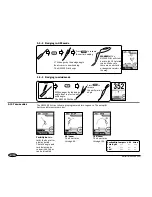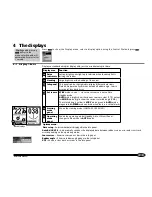
27
Reference Manual
Profiles are used to store a range of autopilot
settings for different sea, environmental and vessel
conditions. Up to 5 user profiles may be configured
(see section 8-2).
Profile
Select the current profile to use.
Options can be selected to set autopilot operating limits:
Dodge angle
Sets size of the dodge angle steps in degrees.
Minimum = 5˚; maximum = 30˚
Tack mode
Auto – vessel tacks to the same set wind angle
but on the opposing tack.
Set angle
– vessel tacks through an angle set in Tack
angle, then steers to the same set wind angle but
on the opposing tack.
Tack angle
Set tack angle if Set angle is selected in Tack mode.
Minimum = 50˚; maximum = 160˚
Gybe mode
Off – gybing is disabled.
Auto
– vessel gybes to the same set wind angle
but on the opposing tack.
Set angle – vessel gybes through an angle set
in Gybe angle, then steers to the same set wind
angle but on the opposing tack.
Vessel type can be selected to alter the performance
characteristics of the autopilot depending on the
vessel hull type:
Vessel type
Select Planing, Displacement or Sailing.
Warning:
Changing the vessel type causes the
steering parameters to be reset to default values in
the current profile.
6-2 Setup > Profiles
6-3 Setup > Options
Gybe angle
Set gybe angle if Set angle is selected in Gybe mode
Minimum = 40˚; maximum = 140˚
Tack delay
Set delay that the autopilot will use from the time a
Tack is requested to the time a Tack is carried out
by the autopilot.
Minimum = 0; maximum = 120 (seconds)
Turn Rate
Set the maximum turn rate you want the autopilot to use.
Minimum = 3; maximum = 20 (˚/second)
6-4 Setup
>
Vessel
Drive type
Configures the autopilot to drive the type of
steering system. See installation manual for details.
Edit name
Use to edit the name of the currently selected
profile (see section 8-2).
Parameters
Opens the Parameters menu (see section 8-1).
















































